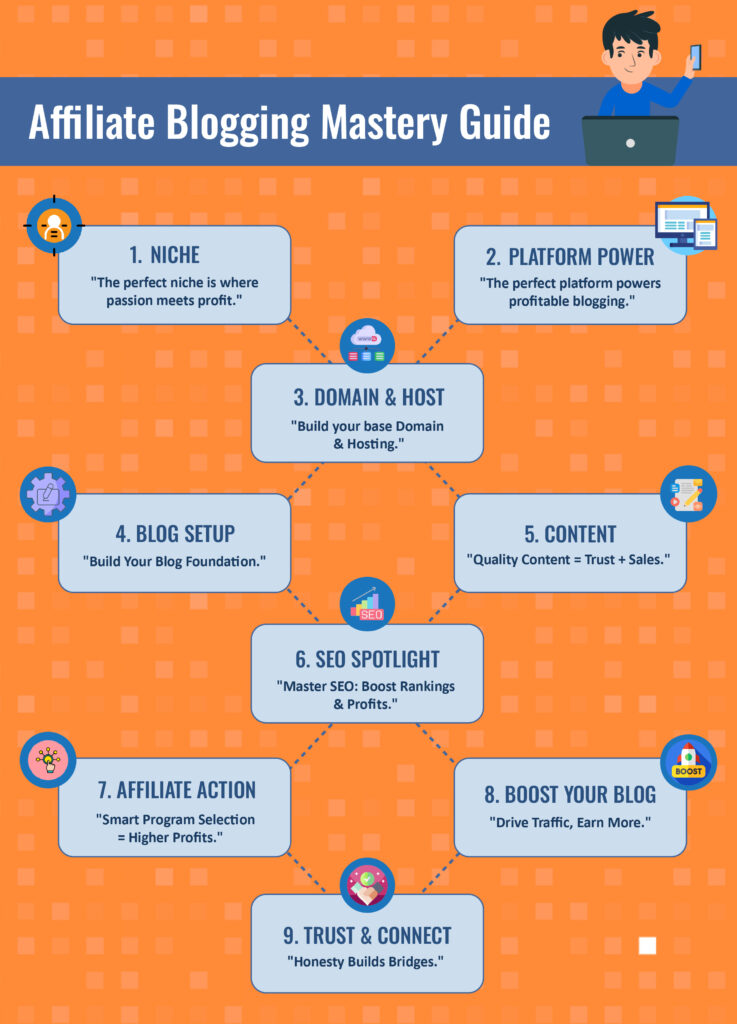[Disclosure: This post may contain affiliate links. If you click on one of these links and make a purchase, we may earn a commission at no extra cost to you. We only recommend products we believe will add value to our readers. For more info read our full Affiliate Disclosure]
So, you’ve heard about affiliate marketing and how people are making money with their blogs, right? Sounds cool, doesn’t it? Imagine earning passive income while sharing stuff you love with the world. Yep, that’s affiliate marketing for you! If you’re ready to start your blog and turn it into a money-making machine, let’s dive in together. Don’t worry—I’ll explain everything step by step, and before you know it, you’ll be running your own awesome blog.
1. What Even is Affiliate Marketing?
Okay, let’s break it down. Affiliate marketing is when you promote someone else’s product or service on your blog. If someone clicks your special link and buys it, you get paid a commission. It’s like being a virtual salesperson, but way cooler because you can do it all from your laptop (or your phone!).
Quick Example
Let’s say you love gaming. You write about your favorite gaming headset on your blog, include a link to Amazon, and BOOM—someone clicks and buys it. Cha-ching! You just earned a commission.
2. Picking a Niche (a.k.a. Your Blog’s Vibe)
This is super important. A niche is like the theme of your blog. What are you into? Gaming? Fitness? Fashion? Whatever it is, choose something you actually like because you’ll be writing about it a lot. Here’s how to find the perfect niche:
- Do What You Love: If you’re passionate about it, blogging won’t feel like work.
- Check What’s Popular: Use tools like Google Trends to see what people are searching for.
- Don’t Get Lost in a Crowd: If there are a million blogs about your topic, try finding a unique angle. Instead of general fitness, you could focus on fitness for teens or home workouts.
3. Where Do You Even Start a Blog?
Good news: starting a blog is easy these days! You don’t need to know coding or be some tech genius. Platforms like WordPress.org are perfect for beginners (and pros). Here are a few options:
- WordPress.org: Tons of customization, perfect for long-term growth.
- Blogger: Simple and free but kind of basic.
- Wix: Drag-and-drop easy, but it can get expensive.
For affiliate marketing, WordPress is the GOAT (greatest of all time). It’s flexible, and you can add plugins to make things super easy.
4. Picking a Blog Name That Pops
This is the fun part! Your domain name (a.k.a. your blog’s address) should be short, catchy, and easy to remember. For example, if your niche is gaming, something like “GameLife101.com” could work. Once you’ve got a name, you’ll need hosting (think of it like renting space on the internet). Popular hosting sites include:
- Bluehost: Affordable and beginner-friendly.
- SiteGround: Great customer service and fast.
- HostGator: Solid for first-timers.
- Namecheap: Affordable domains with great customer support.

5. Setting Up Your Blog (a.k.a. Getting Fancy)
Now it’s time to actually build your blog. Don’t freak out—it’s easier than you think. Most hosting providers have a one-click WordPress installation. Once it’s set up:
- Pick a Theme: Think of this as your blog’s outfit. Choose something clean and mobile-friendly.
- Add Plugins: These are like apps for your blog. Here are some must-haves:
- Yoast SEO: Helps your blog get noticed by Google.
- ThirstyAffiliates: Makes managing your affiliate links super easy.
- MonsterInsights: Tracks your blog’s traffic.
6. Making Your Blog Look Cool (Branding Time!)
Your blog should scream YOU. This is where branding comes in. Think about your logo, colors, and overall vibe. If you want your blog to feel professional and fun, use tools like Canva to create your branding elements.
- Logo: Make it simple but memorable.
- Color Scheme: Pick 2-3 colors that represent your blog’s vibe.
- Fonts: Keep them easy to read but stylish.
7. Writing Content People Actually Want to Read
Here’s the thing—your content is what will make people come back to your blog (and trust you enough to click your affiliate links). So, write stuff that’s helpful, fun, and easy to understand. Some ideas:
- Product Reviews: Talk about what you love (or don’t love) about a product.
- How-To Guides: Teach people how to do something step by step.
- Lists: People love lists! Think “Top 10 Gaming Laptops” or “5 Best Skincare Products for Teens.”
Pro Tip: Be honest. If you don’t genuinely like a product, don’t promote it. Your readers will trust you more if you keep it real.
8. Getting People to Actually Read Your Blog (SEO Tools You Need!)
SEO might sound like a boring tech term, but it’s basically how Google finds your blog. Here’s what you need to do and the tools that can help:
- Find Keywords: Tools like SEMrush or Ahrefs help you discover what people are searching for (e.g., “best gaming mouse”).
- Track Your Progress: Use Google Analytics to see how people interact with your blog and Wincher to track your keyword rankings.
- Sprinkle Keywords Naturally: Add these keywords to your titles, headings, and content (but don’t overdo it).
- Use Google Search Console: This free tool helps ensure your site is performing well on Google.
9. Adding Personal Experience to Build Trust
People connect with stories, so share your journey! Did you struggle to pick your niche? What was it like writing your first blog post? Adding bits of your personal experience makes your blog relatable and authentic. Plus, it builds trust with your readers. If you’ve already had success earning affiliate income, talk about that too! People love hearing real success stories.
10. Joining Affiliate Programs (Where the Money Comes From)
Alright, let’s talk money. To make commissions, you need to join affiliate programs. Here’s how:
- Sign Up for Affiliate Networks: Platforms like Amazon Associates, ShareASale, ClickBank, and CJ Affiliate connect you with brands.
- Look for High Commissions: The higher the percentage, the more you make per sale.
- Stick to Relevant Products: Promote stuff your audience actually cares about.
11. Exploring Marketing Channels to Boost Traffic
Having a blog is just the start. To get more people to read it, you’ll need to use different marketing channels:
- Social Media: Post your blog content on Instagram, TikTok, or Facebook.
- YouTube: Create videos that link back to your blog.
- Email Marketing: Send out newsletters with updates and tips using tools like AWeber or GetResponse.
Each channel has its own vibe, so figure out where your audience hangs out and focus there.
12. Getting the Word Out (Promoting Your Blog)
No one’s going to read your blog if they don’t know it exists. Here’s how to spread the word:
- Social Media Strategies: Share your posts on Instagram, Twitter, and TikTok.
- Email Newsletters: Build a list of subscribers and send them updates.
- Guest Posts: Write for other blogs to get more exposure.
- Paid Ads: Use Google or Facebook ads to reach more people (once you’re ready to invest).
13. Building Trust with Your Audience
Here’s the golden rule: people won’t click your links if they don’t trust you. So, always be honest and transparent:
- Disclose Your Links: Let readers know you’ll earn a commission if they buy.
- Focus on Value: Help your audience solve their problems.
- Engage: Reply to comments and connect with your readers on social media.
FAQs (Your Questions, Answered!)
- How long until I make money?
It depends, but usually a few months to a year. Just keep at it!
- Do I need a huge audience?
Nope! A small but engaged audience can work wonders.
- Can I use affiliate links on social media?
Totally, but remember to disclose them.
- What’s the best affiliate program for beginners?
Amazon Associates is a solid starting point.
- Do I need to tell people about affiliate links?
Yes, it’s the law! Add a quick disclaimer to your posts.
Wrapping It Up
Starting an affiliate marketing blog might sound overwhelming, but trust me—you’ve got this! Take it step by step, stay consistent, and most importantly, have fun with it. It’s not just about making money; it’s about sharing what you love and helping others along the way.
Ready to start your journey? Let’s do this!
[Disclosure: This post may contain affiliate links. If you click on one of these links and make a purchase, we may earn a commission at no extra cost to you. We only recommend products we believe will add value to our readers. For more info read our full Affiliate Disclosure]






